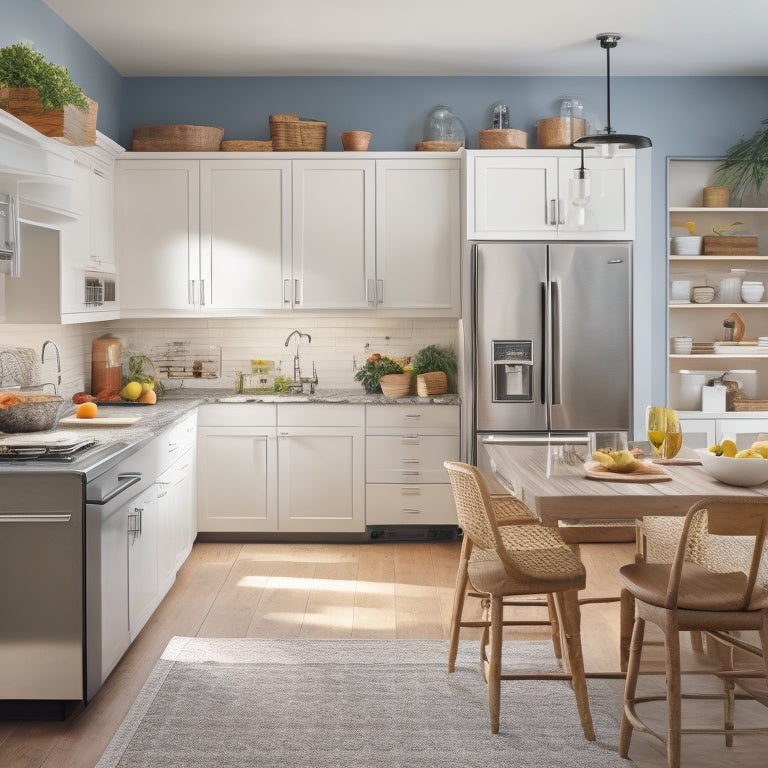
What's the Best Way to Organize Diet-Friendly Kitchen?
Share
To create a diet-friendly kitchen, start by evaluating your dietary needs and goals. Consider consulting a registered dietitian for personalized guidance. Next, purge your kitchen of unhealthy foods and declutter your countertops to create a clean slate. Categorize and group similar items together, using labels and color coding to differentiate categories. Invest in storage solutions like kitchen carts and pegboards to maximize functionality. Finally, designate specific zones for meal prep, cooking, and cleanup to optimize your workflow. As you set up your kitchen, you'll be amazed at how these simple changes can set you up for healthy eating success - and the best part is, there's even more to explore.
Key Takeaways
• Assess your diet needs and goals to create a personalized kitchen organization plan that supports healthy eating habits.
• Purge and declutter your kitchen by eliminating unhealthy foods and replacing them with whole, nutritious options.
• Categorize and group similar items together, using labels and color coding to create a visually appealing and functional space.
• Designate specific zones for meal prep, cooking, and cleanup to optimize workflow and increase efficiency.
• Invest in storage solutions, such as kitchen carts and pegboards, to maximize kitchen functionality and keep appliances organized.
Assessing Your Diet Needs
To get started on organizing a diet-friendly kitchen, take stock of your dietary goals, restrictions, and preferences, as this will help you determine what foods and ingredients to prioritize. Consider consulting with a registered dietitian or nutritionist to get personalized guidance on meal planning and grocery shopping. They can help you identify areas for improvement and create a tailored plan that suits your lifestyle.
Next, think about how you'll track your food intake and portion control. Are you a fan of digital apps or do you prefer a physical food diary? Whichever method you choose, make sure it's one that you'll stick to consistently. Accurate tracking will help you stay on top of your macronutrient intake, identify patterns, and make adjustments as needed.
Purge and Declutter Kitchen
As you start organizing your diet-friendly kitchen, it's time to get rid of the unhealthy foods and clutter that's holding you back. You'll want to toss those tempting treats and expired ingredients that sabotage your diet goals and clear off countertops to create a clean slate.
Toss the Unhealthy Food
Get rid of the unhealthy food lurking in your pantry, fridge, and kitchen cabinets, and take the first step towards a diet-friendly kitchen. It's time to be ruthless – if it's high in sugar, salt, or unhealthy fats, it's got to go.
Don't worry, you can replace those unhealthy staples with healthy substitutions that'll make meal prep a breeze. Say goodbye to processed snacks and sugary drinks, and hello to whole foods like fruits, veggies, and lean proteins.
Clear Off Countertops
You're left with a clean slate after purging your kitchen of unhealthy foods, and now it's time to tackle the clutter on your countertops, where appliances, gadgets, and other items may be competing for space. This is your opportunity to create a functional layout that supports your healthy eating goals.
To maximize your counter space, consider the following:
-
Designate zones: Allocate specific areas for food prep, cooking, and storage to maintain a sense of order.
-
Invest in storage solutions: Choose multi-functional appliances and gadgets that can be easily stowed away when not in use.
-
Embrace a minimalist design: Keep only the essentials on display, and store the rest out of sight to reduce visual clutter.
Categorize and Group Similar
By categorizing and grouping similar items, you'll create a sense of visual flow in your kitchen, making it easier to find what you need when you need it. This simple step can save you time and reduce stress while cooking. Start by grouping similar items together, such as baking supplies, cooking utensils, and snacks.
Then, take it a step further by labeling containers and using color coding to differentiate between categories. For instance, you can use blue labels for baking supplies and green for cooking utensils.
To take your organization to the next level, utilize drawer dividers and shelf organizers to keep items off the countertops and out of the way. This won't only create more space but also prevent clutter from building up in the future.
Storage Solutions for Appliances
Now that your kitchen is organized by category, it's time to tackle the often-bulky appliances that can quickly clutter up countertops, making it difficult to maintain your newly created healthy eating space.
To maximize your kitchen's functionality, you need to find a way to keep your appliances organized and out of sight.
Here are some storage solutions to contemplate:
-
Invest in a kitchen cart or island with hidden storage to stash away small appliances like toasters and blenders.
-
Install a pegboard on a wall or the back of a cabinet door to hang frequently used items like stand mixers and food processors.
-
Utilize the space above your cabinets by installing an appliance garage or a slide-out storage unit to store less frequently used items like slow cookers and bread machines.
Designate Zones for Efficiency
Designating specific zones within your kitchen for meal prep, cooking, and cleanup optimizes your workflow, saving you time and energy. By creating distinct areas for each task, you'll reduce clutter, enhance zone organization, and make meal prep a breeze.
For instance, designate a zone near the stove for cooking, with utensils, spices, and oils within easy reach. A meal prep zone near the counter or island can hold your cutting boards, knives, and storage containers. This layout design guarantees you're not constantly walking back and forth across the kitchen, increasing efficiency.
In your cleanup zone, consider placing the sink, dishwasher, and trash can together to minimize mess and effort. This zone organization also helps maintain a clean and hygienic kitchen. Remember to tailor your zones to your personal needs and cooking habits.
Utilize Vertical Space Wisely
Make the most of your kitchen's vertical space by installing shelves, hooks, or a pegboard to keep frequently used items, such as pots, pans, utensils, and spices, within easy reach. This won't only free up counter space but also make meal prep a breeze.
By utilizing vertical space, you'll be able to quickly access the items you need, saving you time and energy.
Here are some ways to maximize your kitchen's vertical space:
-
Install wall shelves to store less frequently used items, like special occasion dishes or cookbooks, keeping them out of the way but still accessible.
-
Use hanging baskets to store fresh fruits and veggies, keeping them visible and within reach.
-
Add a pegboard to hang utensils, pots, and pans, keeping them organized and easy to grab.
Maintaining Your New System
Now that you've set up your diet-friendly kitchen, it's time to make it a sustainable part of your lifestyle.
To keep your new system running smoothly, you'll need to develop daily habits that support your healthy eating goals.
Daily Habit Formation
By incorporating small, achievable tasks into your daily routine, you'll be more likely to maintain your diet-friendly kitchen and turn healthy habits into second nature. This is where daily habit formation comes in – it's the key to making positive changes stick.
Here are three essential habits to focus on:
-
Meal prep like a pro: Allocate 30 minutes each Sunday to prep healthy meals for the week ahead. This will save you time during the week and make sure you're eating nutritious food.
-
Master mindful eating: Take 10 minutes each day to focus on your hunger and fullness cues. Eat slowly, savor your food, and stop when you're satisfied (not stuffed).
-
Practice portion control: Set aside 5 minutes each day to measure out ingredients and portion your meals. This will help you develop a better understanding of healthy serving sizes and reduce food waste.
Staying on Track
Establishing a routine maintenance schedule helps you stay on track with your diet-friendly kitchen, maintaining that healthy habits continue to thrive over time. You've worked hard to set up your kitchen for success, and now it's time to sustain that momentum.
Start by scheduling regular meal planning and grocery shopping sessions to make sure you're always stocked with healthy options. This will help you avoid last-minute takeout or fast food runs that can derail your diet.
To further support your healthy habits, focus on portion control and mindful eating. Use measuring cups or a food scale to measure your serving sizes, and take your time while eating to truly savor your food. This will help you develop a healthier relationship with food and reduce overeating.
Frequently Asked Questions
How Do I Maintain Motivation to Stick to My Diet-Friendly Kitchen Habits?
"Can you honestly say you're not tired of feeling like a diet failure? You won't, once you master daily affirmations, find an accountability partner, prep meals like a pro, and set achievable goals - the ultimate recipe for unwavering motivation!"
Can a Diet-Friendly Kitchen Be Achieved on a Limited Budget?
You can achieve a diet-friendly kitchen on a limited budget by implementing budget-friendly tips, such as repurposing containers and using affordable tools, and getting creative with DIY solutions to maximize your space.
Are There Specific Kitchen Tools Essential for a Diet-Friendly Kitchen?
You might think you need a pricey kitchen overhaul, but don't worry, you can still create a diet-friendly space on a budget. Invest in essential kitchen gadgets, smart storage solutions, and tools that simplify meal prep and portion control.
How Often Should I Reassess and Adjust My Diet-Friendly Kitchen Organization?
You'll want to reassess your diet-friendly kitchen organization regularly, ideally every 3-6 months, to make adjustments as your needs and preferences change, ensuring continued improvements and best results.
Can a Diet-Friendly Kitchen Coexist With Non-Dieting Family Members?
You can absolutely create a diet-friendly kitchen that coexists with non-dieting family members; it's all about managing family dynamics and dietary differences through meal planning and clever compromise strategies that work for everyone.
Related Posts
-

What Makes an Efficient Walk-In Closet System?
You create an efficient walk-in closet system by combining customizable shelves and storage that cater to your unique...
-

What's the Best Home Organization Online Course?
You're looking for a high-quality home organization online course to simplify your space and life. With so many optio...
-

Creative Solutions for Cabinet Storage Organization
You're sitting on a cache of untapped storage potential, with your cabinets hiding a wealth of creative solutions wai...


